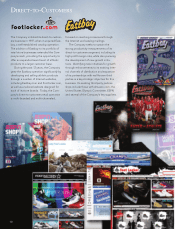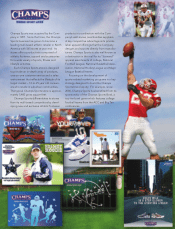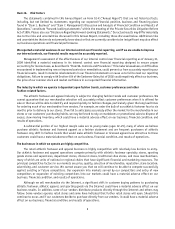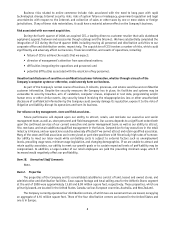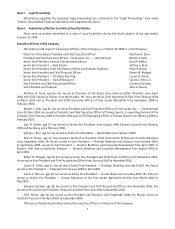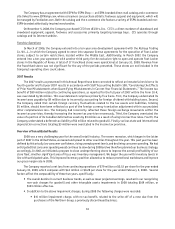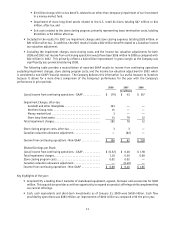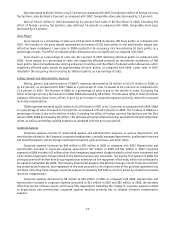Foot Locker 2008 Annual Report Download - page 20
Download and view the complete annual report
Please find page 20 of the 2008 Foot Locker annual report below. You can navigate through the pages in the report by either clicking on the pages listed below, or by using the keyword search tool below to find specific information within the annual report.4
Our operations may be adversely affected by economic or political conditions in other countries.
Approximately 28 percent of our sales and a significant portion of our operating results for 2008 were attributable
to our sales in Europe, Canada, New Zealand, and Australia. As a result, our business is subject to the risks associated
with doing business outside of the United States, such as foreign governmental regulations, foreign customer
preferences, political unrest, disruptions or delays in shipments, and changes in economic conditions in countries
in which we operate. Although we enter into forward foreign exchange contracts and option contracts to reduce the
effect of foreign currency exchange rate fluctuations, our operations may be adversely affected by significant changes
in the value of the U.S. dollar as it relates to certain foreign currencies.
In addition, because we and our suppliers have a substantial amount of our products manufactured in foreign
countries, our ability to obtain sufficient quantities of merchandise on favorable terms may be affected by governmental
regulations, trade restrictions, and economic, labor, and other conditions in the countries from which our suppliers
obtain their product.
Our business is subject to economic cycles and retail industry conditions. Purchases of discretionary athletic
footwear, apparel, and related products, tend to decline during recessionary periods when disposable income is low and
customers are hesitant to use available credit.
The effect of deteriorating global economic conditions and financial markets may adversely affect our business.
The Company’s performance is subject to global economic conditions and the related impact on consumer spending
levels, which have declined recently due to the current economic slowdown. Some of the factors affecting consumer
spending are employment, levels of consumer debt, reductions in net worth as a result of recent severe market declines,
residential real estate and mortgage markets, taxation, fuel and energy prices, interest rates, consumer confidence,
as well as other macroeconomic factors. Consumer purchases of discretionary items, including merchandise we sell,
generally decline during recessionary periods and other periods where disposable income is adversely affected. The
downturn in the global economy may continue to affect customer purchases for the foreseeable future and may
adversely impact our business, financial condition and results of operations. In addition, declines in our profitability
could result in a charge to earnings for the impairment of goodwill, which would not affect our cash flow but could
decrease our earnings, and our stock price could be adversely affected.
The recent distress in the financial markets has resulted in extreme volatility in security prices and diminished
liquidity and credit availability. There can be no assurance that our liquidity will not be affected by changes in the
financial markets and the global economy. Although we currently do not have any borrowings under our revolving credit
facility (other than amounts used for standby letters of credits), tightening of the credit markets could make it more
difficult for us to access funds, refinance our existing indebtedness, enter into agreements for new indebtedness or
obtain funding through the issuance of the Company’s securities. In addition, the current credit situation is having a
significant negative impact on businesses around the world, and the impact of this situation on our major suppliers
cannot be predicted. The Company relies on a few key vendors for a majority of its merchandise purchases (including
a significant portion from one key vendor). The inability of key suppliers to access liquidity, or the insolvency of
key suppliers, could lead to their failure to deliver our merchandise. Our inability to obtain merchandise in a timely
manner from major suppliers could have a material adverse effect on our business, financial condition, and results of
operations.
If our long-lived assets, goodwill or other intangible assets become impaired, we may need to record significant
non-cash impairment charges.
We review our long-lived assets, goodwill and other intangible assets when events indicate that the carrying
value of such assets may be impaired. Goodwill and other indefinite lived intangible assets are reviewed for impairment
if impairment indicators arise and, at a minimum, annually. We determine fair value based on a combination of a
discounted cash flow approach and market-based approach. If an impairment trigger is identified, the carrying value is
compared to its estimated fair value and provisions for impairment are recorded as appropriate. Impairment losses are
significantly affected by estimates of future operating cash flows and estimates of fair value. Our estimates of future
operating cash flows are identified from our three-year plans, which are based upon our experience, knowledge and
expectations; however, these estimates can be affected by such factors as our future operating results, future store
profitability, and future economic conditions, all of which can be difficult to predict.




